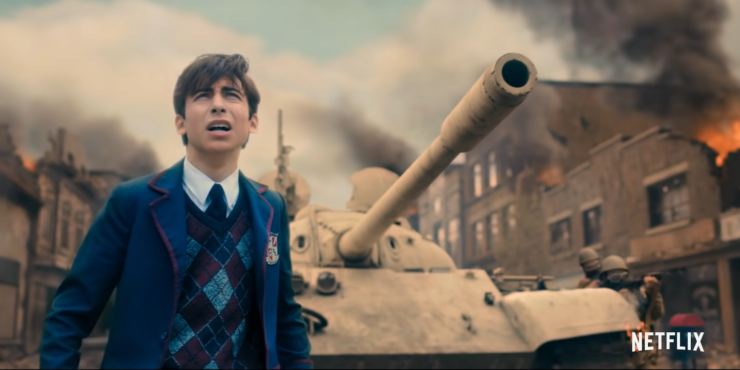After a triumphant first season, The Umbrella Academy returns to Netflix with a new story arc. Based on the various comic book miniseries by Gerard Way and Gabriel Bá (who are also co-executive producers of the TV adaptation), this second season borrows bits and pieces from the comics miniseries Dallas, but mostly tells its own story.
On the one hand, it delivers pretty much the same basic beats as season one. On the other hand, the story is leaner, more coherent, better structured, and makes excellent use of all seven of the main characters.
SPOILERS FOR THE UMBRELLA ACADEMY SEASON TWO HEREIN! YOU HAVE BEEN WARNED!
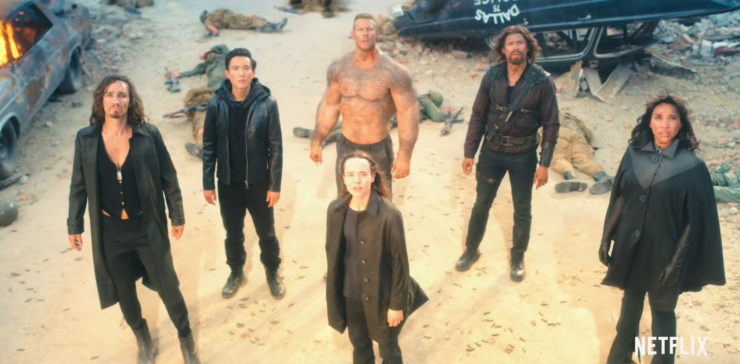
Just like season one, the overall story arc is the same in season two: Five (a fifty-eight-year-old trained assassin for the Time Commission trapped in the body of his prepubescent self) has travelled back in time and must stop the apocalypse from happening by convincing his siblings to work together.
This time, though, it’s a bit more complicated. Season one ended with the world blowing up in 2019 and Five taking himself and all of his siblings back in time before everything went boom. But, just as he did the first time, he screwed things up. They all wound up in an alley in downtown Dallas, but they were spread throughout various time periods between 1960 and 1963.
Five himself winds up on the 25th of November 1963 in the midst of a nasty war between the U.S. and the U.S.S.R., which ends with a nuclear holocaust. He then goes back ten days to try to find the others and avert yet another apocalypse…
The story itself is not all that original—Chris Claremont and Art Adams did a similar thing in the brilliant New Mutants Special Edition #1 in 1985—but it’s the execution that matters, and it’s absolutely brilliant here. By spreading the main characters across different timelines, they each get their own story, one that converges on Dallas just before President John F. Kennedy’s assassination on the 22nd of November, 1963. Each character gets a chance to breathe and have a compelling storyline.
Diego in particular is served well by this, as he was pretty much nowhere in season one. (Also true of the comic book version of the character, who’s mostly just a guy who broods. At one point, Five describes him thusly: “Think Batman—then aim lower,” which pretty much nails it.) But here he gets a great through line, as he spends all his time doing everything he can to prevent JFK’s death—to the point where he’s arrested outside Lee Harvey Oswald’s house and put in a sanitarium.
(I adore the fact that at no point does Five mention to Diego that—as was revealed in season one, and which gets play toward the end of season two—Five’s last mission as a Time Commission assassin was to be on the grassy knoll to make sure that JFK really was shot dead.)
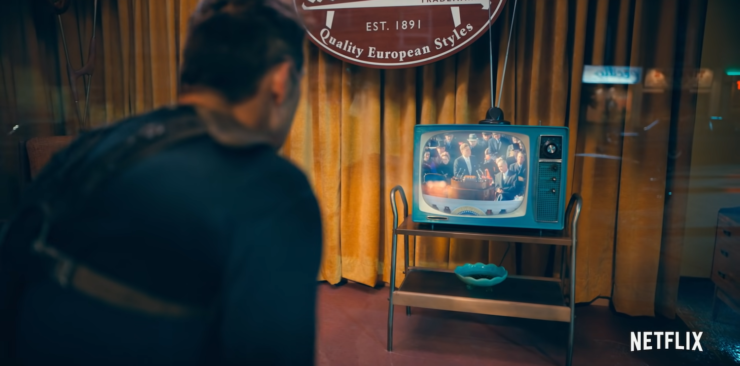
While in the loony bin, Diego starts a bizarre relationship with fellow inmate Lila (played with psychotic verve by Ritu Arya), who helps him escape—and then turns out to be much more than she seems. Arya and David Castañeda have superb chemistry, and the latter is a much stronger presence as a Diego who just wants to do what’s right, and is a bit too single-minded in his pursuit of it. His long hair and beard make him look a lot like the late New Zealand actor Kevin Smith (Ares on Xena and Hercules), and his performance is reminiscent of Smith as well, and that’s only a good thing. Diego’s focus on trying to be a hero gives the season a lot of its heart.
This is especially important because the sibling with the greatest purity of purpose in season one is completely disillusioned. The events of the first season have taken their toll on Luther, who has completely run out of fucks to give, and we find him working for Jack Ruby (the gangster who killed Oswald) as an enforcer and an underground fighter. (In a nice touch, Luther uses all kinds of MMA techniques when he fights, but the guys he fight just punch a lot, as befitting the time period.) When Five finds him and tries to recruit him to stop the apocalypse, Luther—whom Five approached precisely because he figured he’d be the easiest to convince—tells him to go jump in a lake. Luther has been metaphorically kicked in the balls too many times to play the hero anymore, and it isn’t until he loses everything that he finally starts acting like himself.
(That metaphor is a bit on point, as in the penultimate episode, Luther gets kicked in the balls not-so-metaphorically several times.)
As usual, Luther’s Achilles Heel is his unrequited love for Allison. For her part, Allison had the biggest issue when she landed in Dallas because the area of town where they all wound up was a predominantly white neighborhood. When she goes into a diner to get help, she’s asked to leave by the proprietor pointing at the “WHITES ONLY” sign. She’s then set upon by three white guys, one of whom she punches, and who chase her all the way to a Negro neighborhood, where Allison—who still can’t talk after Vanya sliced her throat in season one—is rescued by the proprietor of a hair salon.
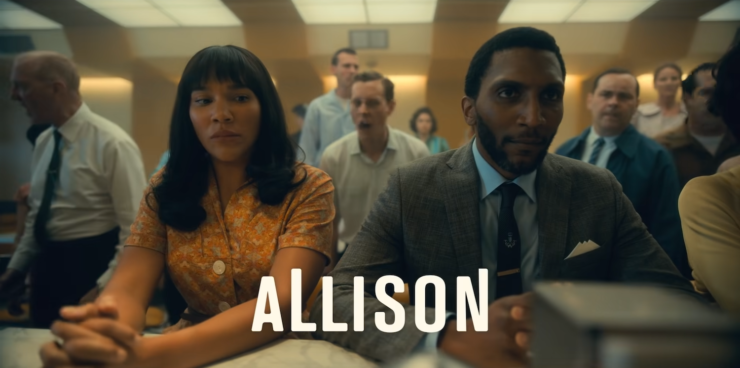
What’s especially interesting is that Allison has the same heroic instinct as Diego, but where Diego defaults to being a superhero, Allison instead chooses a more subtle approach: she gets involved in the fight for Civil Rights, falling in love with the leader of the local movement, Raymond Chestnut. Chestnut is played with quiet charisma by Yusuf Gatewood, and he and Emmy Raver-Lampman have an excellent relaxed chemistry together. Allison and Raymond have only been married a year, but they are a very nice comfortable couple.
Allison also eventually gets her voice back, but she avoids using her “rumor” powers right up until her hand is forced. A sit-in (protesting the “whites only” policy staged at the very same diner she ran into when she first arrived) turns into a riot, and Allison must rumor the cop who is beating Ray to a pulp to get him to stop. Ray is, understandably, freaked and confused—he assumes she bribed the cop or something—forcing Allison to tell him the whole truth.
The Ray-Allison relationship is the only couple in this second season that actually is smooth and happy and bereft of significant issues. (Even Ray’s distress at Allison rumoring the cop goes away in fairly short order.) The same cannot be said for the third couple we encounter, involving Vanya.
The trauma of blowing a hole in the moon and causing it to crash into the Earth in 2019 has taken its toll on Vanya, who is suffering traumatic amnesia. She remembers that her name is Vanya Hargreeves, but nothing else. She also gets hit by a car, but the woman who hit her, Sissy, takes her in, hiring her to be her son’s nanny. The son in question, Harlan, is severely autistic (though it’s 1963, so everyone just thinks he’s slow or whatever, sigh), and Vanya proves a most useful helpmeet to Sissy.
And she soon becomes more than that. Sissy is trapped in a loveless marriage, as her husband, a salesman, does everything he can to stay away from home and his weird son, and Sissy and Vanya wind up falling for each other—though it’s something they can’t admit to and that Sissy is unwilling to commit to beyond a roll in the hay when her husband’s on a business trip, because, well, 1963.

(In the climax, when Five is trying to get them all back to 2019 once and for all, Vanya wants to take Sissy and Harlan with her. Sissy refuses, because this is her time, and I wanted to scream at the television for Vanya—who by this time had all her memories back—to fucking tell her that in 2019 they’re way way way better at treating autistic kids than they are in 1963…)
Ellen Page is never not excellent, and it’s fun to see her spend most of this season not depressed or angry, but instead actually happy.
My favorite, however, is what Klaus does with his time in the 1960s, which is to form his very own cult. Making use of his natural charisma, his ability to commune with the dead, and exploiting an old rich woman who thinks he’s dishy, Klaus forms a cult that’s more late 1960s than early 1960s; multicolored vans and froofy clothes didn’t really kick in until after the Beatles were on Ed Sullivan, but one can chalk this up to Klaus’s own influence, both in coming from 2019 and in having lived temporarily in the late 1960s in season one.
That last bit comes into play, as Klaus got out of Texas in short order, working his way to the Bay Area, but he returns because of what happened to him in Vietnam. Remember, in the first season, Klaus travelled back in time, fought in the Vietnam War, and fell in love with a fellow Marine named Dave, who then died in combat. Recalling Dave telling him that he signed up with the Marines the day after JFK was killed, Klaus returns to Dallas in late November to try to talk Dave out of it. Naturally, he only makes things worse.
I was not kind to Robert Sheehan in my review of season one, but he knocks it out of the park here, going full David Koresh/Charles Manson/Jim Jones, with more than a little bit of the title character from Monty Python’s Life of Brian. Klaus gets pretty quickly fed up with his cult, and tries to divest himself of them more than once, not that he’s in any way successful, as his followers are lost without him. (That’s the Life of Brian comparison: “Will you please all just fuck off?” “How would you like us to fuck off, O Lord?”)
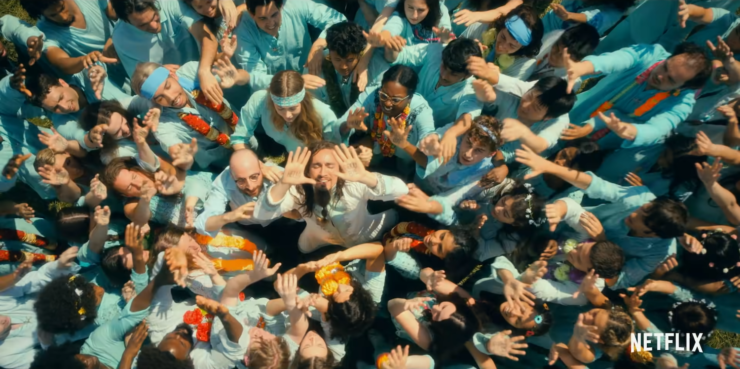
And unlike season one, where Justin H. Min’s Ben—the deceased sibling, who has hung around with Klaus as a ghost because Klaus can still talk to him—was pretty underutilized, he gets a a couple of meaty subplots this time around. First, he figures out how to possess Klaus, who allows him to do so in order for Ben to be corporeal for a bit—and also to declare his love for one of the cultists. (Naturally it goes incredibly poorly, because the Hargreeves children aren’t allowed to have nice things.) But he also gets to save the day when Vanya—once again!—becomes the cause of the apocalypse.
As with last season, it’s hard to entirely blame Vanya. When she and Sissy try to escape with Harlan, they’re caught (Sissy’s brother-in-law is a state trooper), and when Vanya uses her powers to try to get away, the FBI is called in. “Vanya,” after all, sure sounds Russian. So the feds torture her, and she goes full batshit, blowing up the FBI Dallas HQ. That explosion diverts JFK’s motorcade, so he’s never shot, and he assumes the Soviets bombed the FBI, and it devolves into the war Five saw at the top of the season.
But luckily, Ben is there to save the day. He talks Vanya down, which changes history. Min gives Ben a frustrated earnestness that leads to both comedy gold in his scenes with Klaus and heartstring-tugging in his talking down of Vanya. (Credit to Sheehan, who impersonates Min perfectly when Ben possesses Klaus.)
Buy the Book
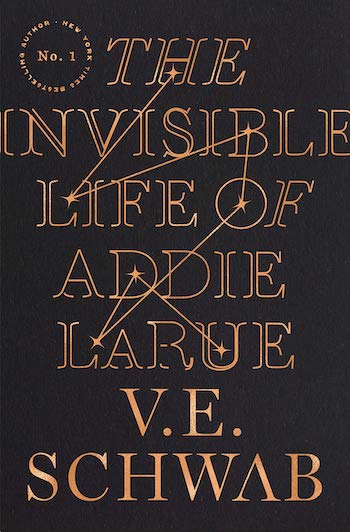

The Invisible Life of Addie LaRue
The rock star of all of this remains Aidan Gallagher as Five. The assorted directors have to engage in some camera trickery—and Gallagher has to slouch a bit—to avoid making it obvious how much Gallagher has grown since they filmed the first season, and he’s not going to be a convincing preadolescent much longer. But once again, he’s the star of the show, the intellectual center of the show, the funniest character in a show full of (very dark) comedy, and also a very frightening assassin when called upon to be so. Gallagher remains utterly convincing as a fifty-eight-year-old man who happens to be in a young body. Simply one of the finest performances you’re likely to see.
The season is not perfect. We finally get the talking-goldfish head of the Time Commission from the comics, only to have him killed off rather easily, to be replaced once again with Kate Walsh’s Handler. Walsh is okay, but not as strong a bad guy as she was last season, which is a problem overall: the antagonists this season are less compelling than they might be. The three Swedes sent by the Time Commission to kill the Hargreeves siblings are not all that interesting (though the final fate of the one Swede who survives to the end of the season is brilliant). Five’s older doppelgänger, played by Sean Sullivan, doesn’t have the same gusto that Gallagher brings to the younger version. The FBI agent who tortures Vanya creates no impression whatsoever. Sissy’s husband is a tired redneck stereotype. And while Colm Feore is once again imperiously yucky as the younger version of Sir Reginald Hargreeves, he’s less effective this season than he was last, with only two exceptions—one is the scene that reveals what readers of the comics have known for ages, that Sir Reginald is, in fact, an alien; the other being the very final scene, which beautifully sets up season three.
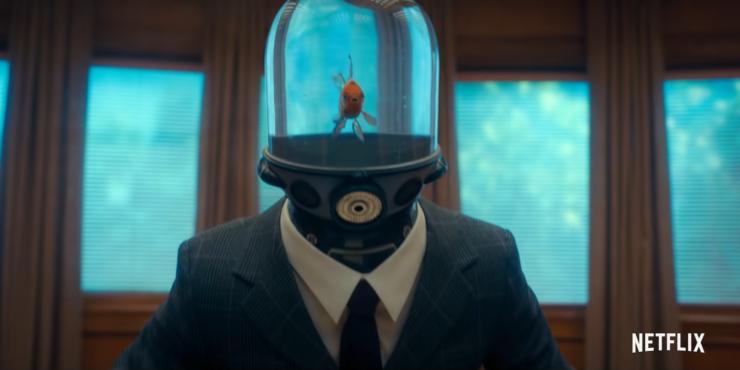
And then there’s Lila. We learn over the course of the season that Lila is the Handler’s adopted daughter, and one of the 43 kids who were all born on the 1st of October 1989. (Finally, we see another one of the remaining 36!) She was placed in the loony bin by the Handler as part of her campaign to get her power back.
Then at the climactic fight in the final episode of the season, we find out that Lila—who’s been a major supporting character throughout all nine previous episodes—also has super powers, and those powers are to mimic those of any powered person near her.
This is pretty much the textbook definition of deus ex machina, and it’s the only writing choice in the entire season that fails utterly, because we’ve had absolutely no indication of this whatsoever prior to the big-ass fight scene at the end.
However, while the villains are pretty unexceptional, the other supporting characters are great. Kevin Rankin does his dim-witted goofball act as Elliott, a conspiracy theorist who only half-willingly provides a home base for Five and the others, John Kapelos makes a good Jack Ruby, Ken Hall is hilarious as Herb the Time Commission bureaucrat, Marin Ireland is superb as Sissy, and most of all, Justin Paul Kelly is amazing as Harlan, in one of the better portrayals of autism I’ve seen. Cameron Britton is also fantastic in his too-brief cameo as Hazel at the top of the season. I’m guessing Britton was too busy on the second season of Manhunt to appear for more than one scene, which is a great loss.
This is a more-than-worthy successor to the excellent first season, especially since it shores up a lot of that season’s weaknesses. Best of all, it ends on a mind-blowing cliffhanger that promises even more delightful shenanigans for season three. I just hope Gallagher doesn’t hit his growth spurt before then…
Keith R.A. DeCandido has been writing for this site since 2011, including rewatches and reviews of various Star Trek TV shows (rewatches of the original series, The Next Generation, Deep Space Nine, and Voyager; reviews of Discovery, Short Treks, Picard, and the upcoming Lower Decks as they’re released), various other comic book adaptations (including The Boys, Warrior Nun, several of Marvel’s Netflix series, and “4-Color to 35-Millimeter: The Great Superhero Movie Rewatch,” which covers every live-action movie based on a superhero comic), and tons more. His recent and upcoming fiction includes the fantasy novels Phoenix Precinct and A Furnace Sealed, the collaborative novels To Hell and Regroup (with David Sherman) and Animal (with Munish K. Batra, MD), the graphic novels Icarus and Jellinek, and short stories in Bad Ass Moms, Across the Universe: Tales of Alternative Beatles, Pangaea III: Redemption, Horns and Halos, and Thrilling Adventure Yarns.










